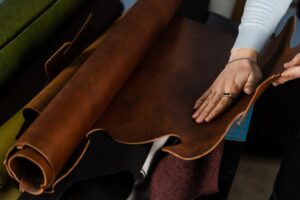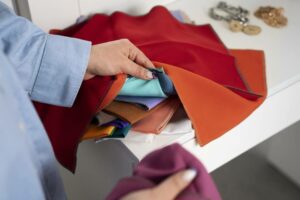Poultry farm tarpaulin and canvas are essential in providing protection and creating an optimal environment for poultry farming.
As pivotal components in the agricultural sector, these materials ensure the safety and well-being of poultry by offering shelter and environmental control.
In this article, we delve into the essentials of poultry farm tarpaulin, exploring aspects such as material significance, weather and UV resistance, and how to identify specific tarpaulin needs.
What are the Essentials of Poultry Farm Tarpaulin
In poultry farming, tarpaulins are essential tools that serve multiple purposes. Here are some features of tarpaulins and canvas that are important for these tasks:
1. Material Significance
Choosing the right material for tarpaulins in a poultry farm is essential because it has a direct impact on how well they perform and how long they last.
For example, the durability of the tarpaulin material helps determine its ability to withstand daily wear and tear, ensuring that it can consistently provide protection for the poultry.
2. Weather and UV Resistance
Poultry farm tarpaulins must be robust enough to endure severe weather conditions, including heavy rains, winds, and extreme temperatures.
Additionally, it’s crucial to incorporate UV protection into these tarpaulins. This helps protect the poultry from heat-related stress and illnesses, ensuring a conducive and healthy environment for their well-being.
Read More: Understanding Recliner Chair Mechanisms: An In-Depth Guide
How to Identify Your Poultry Tarpaulin Needs

When considering an investment in poultry farm tarpaulins, it is essential to first clearly identify your specific needs and requirements. These may include:
1. Analysing Size and Shape
Choosing the correct dimensions and form of a poultry farm tarpaulin is vital for achieving complete coverage and adaptability to different poultry housing structures.
Therefore, it’s crucial to thoroughly assess the unique requirements of your poultry farm in order to select a tarpaulin that offers optimal protection and efficiency.
2. Cost Considerations
Financial planning is another key factor in selecting the right tarpaulin. It’s essential to strike a balance between choosing an economical option and adhering to quality standards.
This ensures that the tarpaulin is not only cost-effective but also effectively fulfils its intended purpose.
What are the Types of Tarpaulins and Their Advantages
Poultry farm tarpaulins come in various types, each with its own set of advantages and ideal use cases.
1. PE Tarpaulins
Polyethylene (PE) tarpaulins, which include both High-Density Polyethylene (HDPE) and Low-Density Polyethylene (LDPE), offer a blend of lightness and resilience.
These qualities make them economical for poultry protection, providing a practical balance between cost and durability.
2. PVC Tarpaulins
Polyvinyl Chloride (PVC) tarpaulins offer superior durability compared to their counterparts. And while they share similar waterproofing and UV resistance qualities with PE tarpaulins, PVC tarpaulins are slightly more expensive.
However, given their enhanced durability, they are worth considering for long-term usage despite the higher initial cost.
3. Canvas
Canvas tarpaulins, despite their higher cost, offer excellent value due to their superior durability and enhanced resistance to harsh weather conditions.
For poultry farms in need of robust and long-lasting protection, they represent a viable and effective option.
How to Install Poultry Farm Tarpaulins

Proper installation of poultry farm tarpaulins is crucial for maximising their effectiveness and extending their lifespan. Key considerations to bear in mind include:
1. Proper Installation Tips
Proper installation of tarpaulins is essential to ensure they are securely anchored and can withstand extreme weather conditions such as strong winds and torrential rains.
Moreover, correct installation not only prevents damage to the tarpaulin but also guarantees optimal protection for the poultry.
2. Maintenance and Care
Regular inspections and prompt repairs are essential for tarpaulin maintenance in poultry farms.
Inspecting for damage and repairing issues like tears or weak seams promptly ensures the tarpaulins continue to protect against weather and environmental elements effectively.
This not only extends the tarpaulin’s life but also safeguards the poultry, contributing to the farm’s overall productivity and efficiency.
3. Cleaning and Storage
Lastly, routine cleaning of tarpaulins is crucial for extending their lifespan and maintaining a hygienic environment for poultry, as accumulated dirt and moisture can cause damage.
Additionally, proper storage of tarpaulins when not in use is vital to prevent deterioration.
Storing them in a dry, cool place is best to protect them from environmental damage, ensuring they are in good condition for future use.
Read More: Safety Vinyl Flooring Malaysia: A Must-Have for Industries
Kintex’s Multipurpose Tarpaulin and Canvas
Poultry farm tarpaulins and canvas play a crucial role in the successful management and safeguarding of poultry farms.
By selecting the right tarpaulin and adequately installing and maintaining it, poultry farmers can ensure a safe and productive environment for their livestock, ultimately contributing to the efficiency and profitability of their farms.
As a leading tarpaulin and canvas supplier, Kintex provides a wide variety of PE, PVC and Canvas collections that can fulfil your poultry farm needs. Contact us to learn more!







